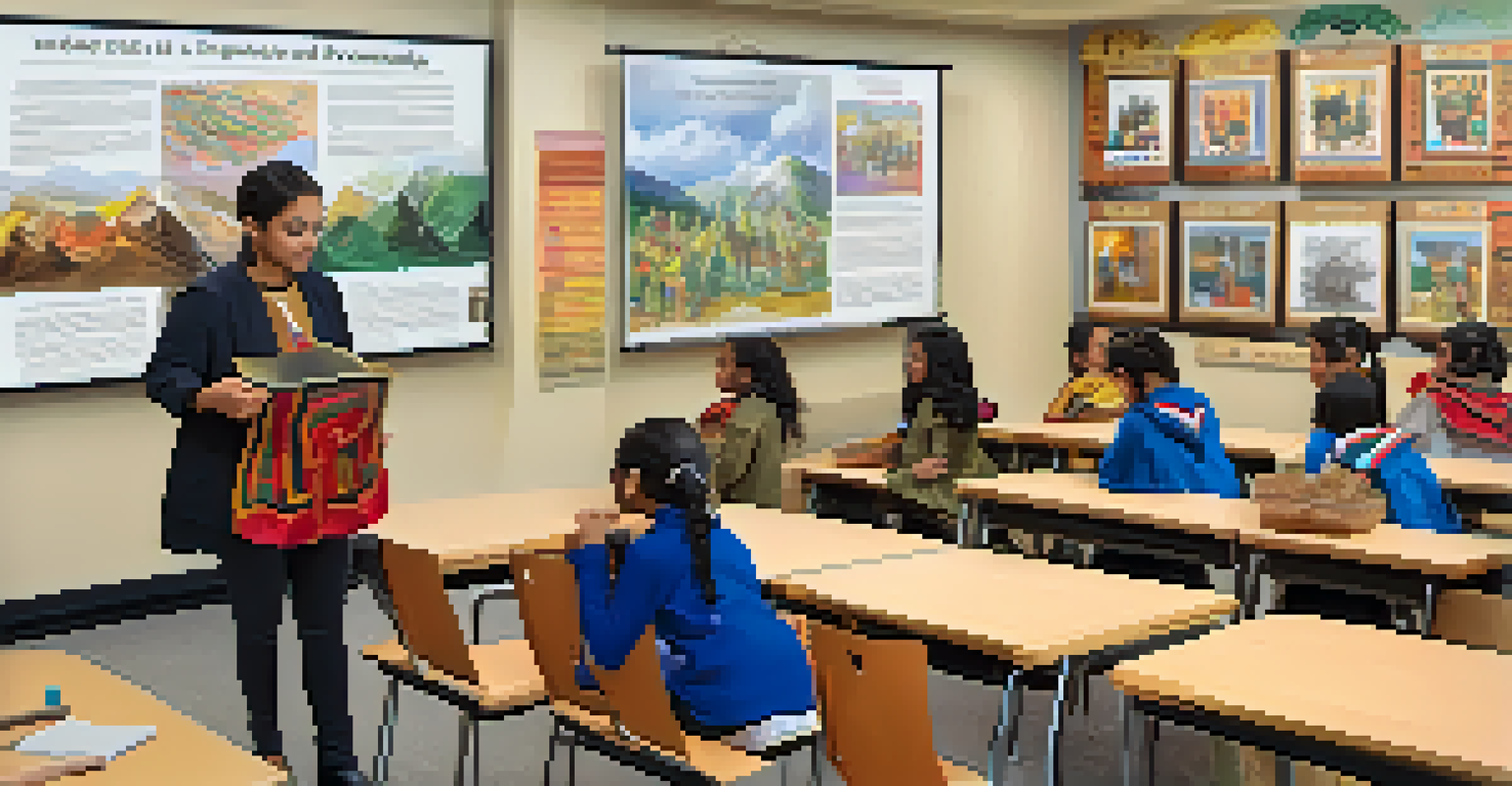The Role of Cultural Narratives in Education

Defining Cultural Narratives in Educational Contexts
Cultural narratives are the stories and values that define a community. In education, these narratives shape how students understand their identities and the world around them. For instance, a school that celebrates a diverse range of cultural stories helps students appreciate their heritage and their peers'. This shared understanding fosters a sense of belonging and community in the classroom.
Education is not the filling of a pail, but the lighting of a fire.
By incorporating cultural narratives into curricula, educators can create a more inclusive environment. When students see their experiences reflected in the material, they are more likely to engage and participate. For example, teaching literature from various cultural backgrounds can inspire discussions that enrich classroom dynamics. It’s not just about reading; it’s about connecting.
Moreover, these narratives can challenge dominant perspectives, offering students a broader view of history and society. This is vital in developing critical thinking skills, as students learn to analyze different viewpoints. Ultimately, understanding cultural narratives is crucial for fostering empathy and respect among students.
The Impact of Cultural Narratives on Student Identity
Cultural narratives play a pivotal role in shaping student identity. When students see their cultures represented in educational materials, it affirms their identities and boosts self-esteem. For example, a student of immigrant background might feel more connected and valued when their cultural stories are included in class discussions.

Conversely, the absence of these narratives can lead to feelings of alienation. When students' backgrounds are overlooked, they may struggle to relate to the curriculum, feeling marginalized. This can hinder their academic performance and overall school experience, emphasizing the importance of inclusive content.
Cultural Narratives Shape Identity
Incorporating cultural narratives in education affirms student identities and boosts self-esteem.
Ultimately, educators must recognize the power of these narratives in fostering positive self-identity among students. By actively incorporating diverse perspectives, schools can help students navigate their identities confidently, preparing them for a multicultural world.
Cultural Narratives as Tools for Social Justice
Cultural narratives can serve as powerful tools for promoting social justice within education. By highlighting stories of marginalized groups, educators can challenge stereotypes and foster critical consciousness among students. This is essential for developing socially responsible citizens who are aware of societal issues.
The single greatest effect on student achievement is not the color of the student’s skin, but the color of the teacher’s skin.
For instance, discussing historical injustices through the lens of personal narratives can create empathy and understanding. Students might learn about civil rights movements through the stories of those who lived them, making history feel more relevant and impactful. This approach encourages students to reflect on their roles in advocating for equality.
Moreover, integrating social justice narratives into the curriculum can empower students to become agents of change. By understanding the struggles and triumphs of others, they are inspired to take action in their communities. Education becomes not just about learning facts, but about fostering a sense of responsibility towards creating a more just society.
Integrating Cultural Narratives into Curriculum Design
Integrating cultural narratives into the curriculum is essential for creating a holistic educational experience. This can be achieved by selecting texts and materials that represent a variety of cultural perspectives. For example, literature from different cultures can be woven into English classes, enriching discussions and expanding worldviews.
Teachers can also encourage students to share their own cultural narratives. This not only validates their experiences but also promotes peer learning. When students present their backgrounds, it fosters respect and curiosity among classmates, building a more cohesive classroom community.
Promoting Social Justice in Education
Cultural narratives can challenge stereotypes and foster critical consciousness, empowering students to advocate for equality.
Additionally, project-based learning that focuses on cultural narratives can enhance engagement and critical thinking. Students might create presentations or projects that explore the significance of their cultural heritage, giving them ownership of their learning. This approach makes education more personal and meaningful.
Challenges of Implementing Cultural Narratives in Education
While the benefits of incorporating cultural narratives are clear, challenges remain in implementation. One major hurdle is the lack of resources that reflect diverse perspectives. Many educators might struggle to find materials that accurately represent various cultures, limiting the richness of the curriculum.
Another challenge is addressing potential biases in the narratives presented. It’s essential for educators to critically assess the stories they choose and ensure they are inclusive and representative. This requires ongoing professional development and a commitment to understanding cultural sensitivities.
Furthermore, educators may face resistance from stakeholders who are accustomed to traditional curricula. To overcome this, it’s crucial to engage parents and community members in discussions about the importance of cultural narratives. Building a collaborative approach can help ease transitions toward more inclusive educational practices.
The Role of Educators in Promoting Cultural Narratives
Educators play a crucial role in promoting cultural narratives within the classroom. They act as facilitators who guide discussions and encourage students to explore diverse perspectives. By modeling open-mindedness and curiosity, teachers can create an environment where cultural narratives thrive.
Moreover, educators need to continuously educate themselves about different cultures and histories. This ongoing professional development equips them to address complex topics thoughtfully and accurately. Workshops, cultural training, and community engagement can enhance their understanding and ability to teach effectively.
Challenges of Implementation
Despite the benefits, educators face hurdles like resource scarcity and potential biases when integrating cultural narratives.
Finally, educators must advocate for policies that support the inclusion of cultural narratives in curricula. By collaborating with school administrators and curriculum developers, they can help create a more equitable educational landscape that values all students' stories.
Future Directions for Cultural Narratives in Education
As education evolves, the integration of cultural narratives will likely become increasingly important. With a growing emphasis on diversity and inclusion, schools are recognizing the need to reflect the world’s complexity in their curricula. This shift can foster a more inclusive environment where every student feels valued.
Technology also plays a significant role in this evolution. Digital platforms can provide access to a vast array of cultural narratives, allowing students to explore and learn from global perspectives. Multimedia resources can enhance engagement and make learning more interactive.

Looking ahead, collaboration among educators, parents, and communities will be vital. By working together to share resources and stories, they can create a richer educational experience for all students. The future of education lies in embracing the diverse narratives that shape our world.